
A black hole is a region of spacetime where gravity is so strong that nothing, including light or other electromagnetic waves, has enough energy to escape it. The theory of general relativity predicts that a sufficiently compact mass can deform spacetime to form a black hole. The boundary of no escape is called the event horizon. Although it has a great effect on the fate and circumstances of an object crossing it, it has no locally detectable features according to general relativity. In many ways, a black hole acts like an ideal black body, as it reflects no light. Moreover, quantum field theory in curved spacetime predicts that event horizons emit Hawking radiation, with the same spectrum as a black body of a temperature inversely proportional to its mass. This temperature is of the order of billionths of a kelvin for stellar black holes, making it essentially impossible to observe directly.
Quantum gravity (QG) is a field of theoretical physics that seeks to describe gravity according to the principles of quantum mechanics. It deals with environments in which neither gravitational nor quantum effects can be ignored, such as in the vicinity of black holes or similar compact astrophysical objects, such as neutron stars as well as in the early stages of the universe moments after the Big Bang.

A gravitational singularity, spacetime singularity or simply singularity is a condition in which gravity is predicted to be so intense that spacetime itself would break down catastrophically. As such, a singularity is by definition no longer part of the regular spacetime and cannot be determined by "where" or "when". Gravitational singularities exist at a junction between general relativity and quantum mechanics; therefore, the properties of the singularity cannot be described without an established theory of quantum gravity. Trying to find a complete and precise definition of singularities in the theory of general relativity, the current best theory of gravity, remains a difficult problem. A singularity in general relativity can be defined by the scalar invariant curvature becoming infinite or, better, by a geodesic being incomplete.
In general relativity, a white hole is a hypothetical region of spacetime and singularity that cannot be entered from the outside, although energy-matter, light and information can escape from it. In this sense, it is the reverse of a black hole, from which energy-matter, light and information cannot escape. White holes appear in the theory of eternal black holes. In addition to a black hole region in the future, such a solution of the Einstein field equations has a white hole region in its past. This region does not exist for black holes that have formed through gravitational collapse, however, nor are there any observed physical processes through which a white hole could be formed.
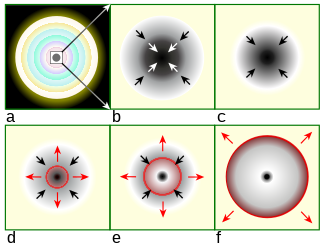
Gravitational collapse is the contraction of an astronomical object due to the influence of its own gravity, which tends to draw matter inward toward the center of gravity. Gravitational collapse is a fundamental mechanism for structure formation in the universe. Over time an initial, relatively smooth distribution of matter will collapse to form pockets of higher density, typically creating a hierarchy of condensed structures such as clusters of galaxies, stellar groups, stars and planets.

In quantum field theory, a false vacuum is a hypothetical vacuum that is relatively stable, but not in the most stable state possible. In this condition it is called metastable. It may last for a very long time in this state, but could eventually decay to the more stable one, an event known as false vacuum decay. The most common suggestion of how such a decay might happen in our universe is called bubble nucleation – if a small region of the universe by chance reached a more stable vacuum, this "bubble" would spread.

John R. Gribbin is a British science writer, an astrophysicist, and a visiting fellow in astronomy at the University of Sussex. His writings include quantum physics, human evolution, climate change, global warming, the origins of the universe, and biographies of famous scientists. He also writes science fiction.
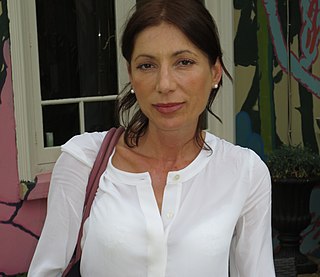
Laura Mersini-Houghton is an Albanian-American cosmologist and theoretical physicist, and professor at the University of North Carolina at Chapel Hill. She is a proponent of the multiverse hypothesis and the author of a theory for the origin of the universe that holds that our universe is one of many selected by quantum gravitational dynamics of matter and energy. She argues that anomalies in the current structure of the universe are best explained as the gravitational tug exerted by other universes.
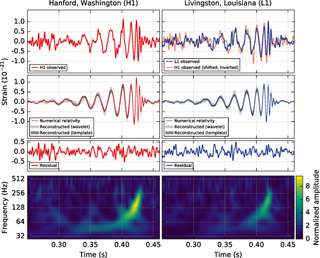
Gravitational-wave astronomy is an emerging field of science, concerning the observations of gravitational waves to collect relatively unique data and make inferences about objects such as neutron stars and black holes, events such as supernovae, and processes including those of the early universe shortly after the Big Bang.

Remo Ruffini. He is the Director of ICRANet, International Centre for Relativistic Astrophysics Network and the President of the International Centre for Relativistic Astrophysics (ICRA). Ruffini initiated the International Relativistic Astrophysics PhD, a common graduate school program of several universities and research institutes for the education of theoretical astrophysicists. He is the Director of the Erasmus Mundus IRAP PhD program. He has been Professor of Theoretical Physics at the University of Rome "Sapienza" from 1978 to 2012.

Stephen William Hawking was an English theoretical physicist, cosmologist, and author who, at the time of his death, was director of research at the Centre for Theoretical Cosmology at the University of Cambridge. Between 1979 and 2009, he was the Lucasian Professor of Mathematics at the University of Cambridge, widely viewed as one of the most prestigious academic posts in the world.

In cosmology, primordial black holes (PBHs) are hypothetical black holes that formed soon after the Big Bang. In the inflationary era and early radiation-dominated universe, extremely dense pockets of subatomic matter may have been tightly packed to the point of gravitational collapse, creating primordial black holes without the supernova compression needed to make black holes today. Because the creation of primordial black holes would pre-date the first stars, they are not limited to the narrow mass range of stellar black holes.
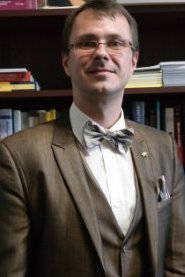
Nikodem Janusz Popławski is a Polish theoretical physicist, most widely noted for the hypothesis that every black hole could be a doorway to another universe and that the universe was formed within a black hole which itself exists in a larger universe. This hypothesis was listed by National Geographic and Science magazines among their top ten discoveries of 2010.
In astrophysics, an event horizon is a boundary beyond which events cannot affect an observer. Wolfgang Rindler coined the term in the 1950s.
A black hole cosmology is a cosmological model in which the observable universe is the interior of a black hole. Such models were originally proposed by theoretical physicist Raj Pathria, and concurrently by mathematician I. J. Good.
Jedidah C. Isler is an American astrophysicist, educator, and an active advocate for diversity in STEM. She became the first African-American woman to complete her PhD in astrophysics at Yale in 2014. She is currently an assistant professor of astrophysics at Dartmouth College. Her research explores the physics of blazars and examines the jet streams emanating from them. In November 2020, Isler was named a member of Joe Biden's presidential transition Agency Review Team to support transition efforts related to the National Aeronautics and Space Administration.
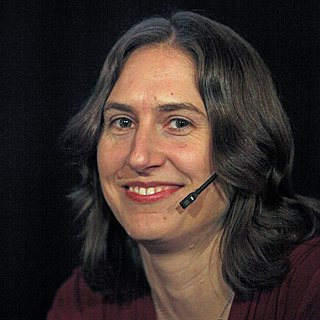
Katherine J. Mack is a theoretical cosmologist who holds the Hawking Chair in Cosmology and Science Communication at Perimeter Institute. Her academic research investigates dark matter, vacuum decay and the epoch of reionisation. Mack is also a popular science communicator who participates in social media and regularly writes for Scientific American, Slate, Sky & Telescope, Time, and Cosmos.
Wanda Díaz-Merced is an astronomer best known for using sonification to turn large data sets into audible sound. She currently works at the European Gravitational Observatory Cascina, Italy. As someone who has lost their eyesight, she is a leader in increasing equality of access to astronomy and using audible sound to study astrophysical data. Wanda has been included in the list of the 7 most trailblazing women in science by the BBC.
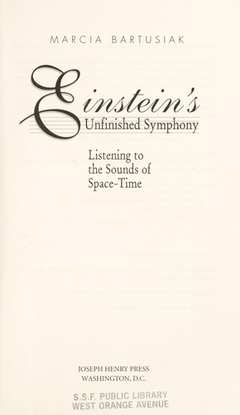
Einstein's Unfinished Symphony: Listening to the Sounds of Space-Time is a 2000 non-fiction book by Marcia Bartusiak about the preliminary work preceding operational efforts to detect the gravitational waves predicted by Einstein's theory of general relativity. She tells the story of LIGO's two gravitational-wave observatories in Louisiana and Washington State, with some mention of other such observatories in Italy, Germany, Japan, and Australia, and the scientists and scientific considerations involved. Initial LIGO operations between 2002 and 2010 did not detect any gravitational waves. After technical enhancements, gravitational waves were first detected in 2016. After the detection, Bartusiak wrote an updated version entitled Einstein's Unfinished Symphony: The Story of a Gamble, Two Black Holes, and a New Age of Astronomy published in 2017 by Yale University Press.

Rana X. Adhikari is an American experimental physicist. He is a professor of physics at the California Institute of Technology (Caltech) and an associate faculty member of the International Centre for Theoretical Sciences of Tata Institute of Fundamental Research (ICTS-TIFR).














